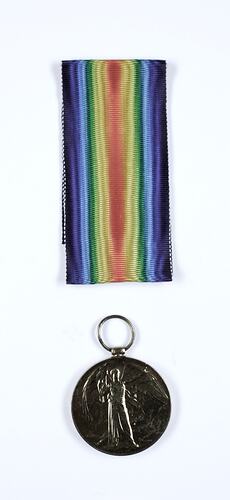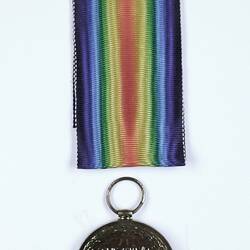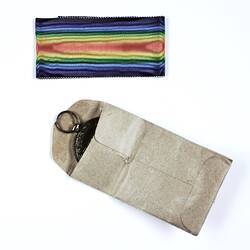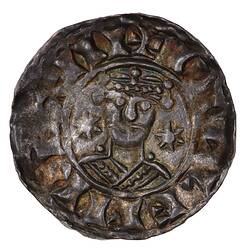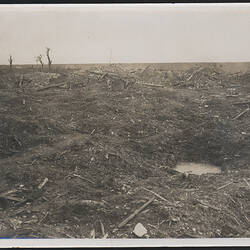Summary
British Victory Medal 1914-1919, awarded to Gunner James Clive Talbot. Part of a collection of material associated with Talbot's World War I service.
James Clive Talbot was a 20-year-old grazier and wool classer from 'Yeo Vale', Birregurra, Victoria, when he enlisted to fight in World War I on 2 April 1915 (service number 1350). As part of the 24th Battalion he served in Gallipoli and on the Western Front. He was killed in action aged 22, on 22 September 1917 in Belgium (during in the Third Battle of Ypres). His father (perhaps both his parents) appears to have taken the unusual step of visiting his grave - out of the reach of many bereaved in Australia. They also placed a blackwood pulpit at the Birregurra Church of England, in memory of their son, who they knew as Clive. It is inscribed '...in loving memory of our beloved son and brother, James Clive Talbot, killed in action September 22nd, 1917, aged 22 years. He has fought a good fight, he has finished his work; he has kept the faith.'
The Victory Medal was authorised in 1919 and was awarded to army, navy and air force personnel who served in a theatre of war between midnight 4-5 August 1914 and midnight 11-12 November 1918. The Allies resolved that, if they wished to issue a Victory Medal, it would share a common feature of a depiction of Victory on the obverse and a ribbon of red, yellow, green, blue and violet merged into a rainbow pattern. This medal, that of Great Britain, was awarded to personnel from countries in the British Empire (some 5,725,000 were issued). The other Allied countries that issued Victory medals were: Belgium, Brazil, Cuba, Czechoslovakia, France, Greece, Italy, Japan, Portugal, Romania, Thailand, Union of South Africa and the United States of America.
Physical Description
A miniature bronze medal with ring mount for ribbon. Ribbon not attached.
Obverse Description
A figure of Victory facing three-quarters right with wings spread; in her right hand she holds a palm branch, her left hand is extended and open.
Reverse Description
The words, THE GREAT . WAR FOR . CIVILISATION 1914 - 1919 within a circular wreath of laurel.
Edge Description
1350 PTE. J.C. TALBOT 24 BN. A. I. F.
Significance
The James Talbot mourning collection is of particular significance since it documents a set of personal effects from a son lost at war, including a tiny photograph and engraved medal presented to his bereaved parents, and his colour patch, buttons and badges. Importantly, it also includes a large certificate from Ypres Reservoir British Cemetery, Belgium, including cemetery images and Talbot's details pasted into a box at the centre. (Further research may link this to his father's visit to the cemetery.) It provides an important insight into the ways Australians memorialized the distant graves of their loved ones (discussed by Bart Ziino in A Distant Grief, and others).
More Information
-
Collecting Areas
-
Acquisition Information
Purchase
-
Date Issued
1919 AD
-
Issued By
-
Mint
-
Artist
-
Person Commemorated
-
Organisation Symbolised
-
Axis
12
-
Classification
-
Category
-
Discipline
-
Type of item
-
Diameter
3 mm (Depth), 50 mm (Height), 36 mm (Outside Diameter)
Diamter of medal
-
Other Dimensions
87 mm (Width), 52 mm (Height)
Brown paper envelope in which medal was contained. Measured flattened out (sits naturally folded)
-
Object Dimensions
230 mm (Length), 38 mm (Width)
Ribbon only, unfolded
-
Shape
Round with loop and ribbon
-
References
[Book] Joslin, E C., et al. 1988. British Battles and Medals., 230 - 1 Pages
-
Keywords
World War I, 1914-1918, Medals, Death & Mourning, Battle of the Somme (Somme Offensive), 1916
